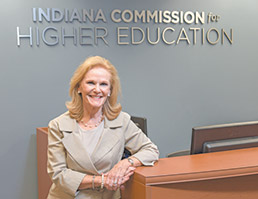Subscriber Benefit
As a subscriber you can listen to articles at work, in the car, or while you work out. Subscribe Now (IBJ Photo/ Eric Learned)
(IBJ Photo/ Eric Learned)Teresa Lubbers, 64, left the Indiana Senate in 2009 to lead the Indiana Commission for Higher Education, which advises and supports the state’s college system but has little oversight or governing authority.
The commission provides universities and policymakers data about college readiness and completion, and workforce preparation. It’s worked with the General Assembly to develop a performance funding model that lets lawmakers allocate more money to colleges that are retaining more students and graduating them quickly.
Lubbers, on workforce readiness:
The jobs of the 21st century are going to require some sort of education and training beyond high school. I’m not saying that everyone needs a four-year degree, but they’ll need some sort of a quality degree or credential beyond high school. So, we’ve set this 60-percent goal—as a lot of states have—that 60 percent of Hoosiers would have those kinds of credentials. We’re at 34.7 percent.
Keep in mind, this is not a graduation rate; this is an attainment level. It’s what percentage of your adult population … [has] associate’s degrees and higher. But what we are carving out now will include one-year workforce certificates and other workforce credentials that are aligned to labor outcomes.
On what’s working in higher education in Indiana:
Well, I do a State of Higher Education address in January or February of every year, and I said if I were to give Indiana a grade right now, I’d give us an “incomplete.” And the reason is because we have in place very promising—and some already realized—changes in the way we conduct the business of higher education.
One area is performance funding. We’ve had financial aid reform that is beginning to show that more students are becoming full-time students whenever possible and their on-time completion rates are improving. And that has been an incredibly difficult number to move in the past. We’ve done a great job improving transfers [among colleges] in Indiana. I don’t hear stories anymore about losing time and credits. We’re finding ways to make sure that, when students enter college, they know exactly what they need to do. So every student has a degree map now.
On what still needs improving:
We still have a significant achievement gap in Indiana. And we passed a resolution that said we were going to close the achievement gap by 2025 and cut it in half by 2018. And I was just meeting with the College Board looking at our numbers and we still have a significant achievement gap of students coming out [of high school] prepared to do college-level work. We can’t meet the 60-percent goal without all areas of the state and all populations doing better.
On trying to bring down college costs:
The 200-percent increases that you saw in tuition over the past two decades is just not a sustainable model. If you’re telling people that education beyond high school is more important than ever, then you need to make sure that families can afford it.
Indiana is a pretty generous state when it comes to need-based financial aid. We actually rank first in the Midwest and seventh in the nation. So we have said to students, through programs like our 21st Century Scholars program, “If you make sure that you’re academically prepared for education beyond high school, we’ll make sure that you can afford it.”
Another area is: What does it actually cost? What are the universities actuallycharging? A few years ago, the Legislature gave the commission a new charge, which we had never been involved with: the setting of tuition at public institutions. Trustees still set those tuitions, but the Legislature called upon us to set non-binding targets for tuition for mandatory fees.
We asked the institutions to be flat or to raise their tuition no more than the rate of inflation and we calculated that at 1.65 percent. Nearly all of our public institutions came in at that level.
Some would say that, over the course of the last decade, you saw huge infusions of technology related to institutions that came with a cost. Some might cite the cost of retirement systems or issues related to the operations of the institutions—not that other enterprises didn’t have the same issues as well. You did see higher increases in higher education than you saw in health care or energy costs or a lot of other costs.
And you saw a huge infusion of students who were entering higher education, many of whom had higher-level needs than [colleges] had seen before in terms of [students’ insufficient] academic preparation.
But at some point, we hit the wall where we were questioning the value of higher education and leaving with debt that couldn’t be discharged in bankruptcy. So I think you saw public pressure.
Click here for other interviews.
Please enable JavaScript to view this content.
